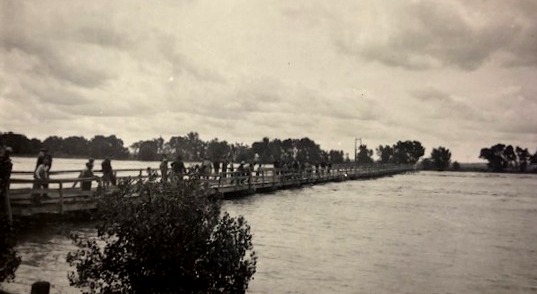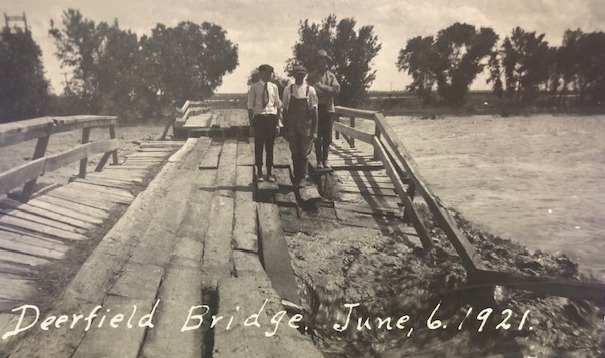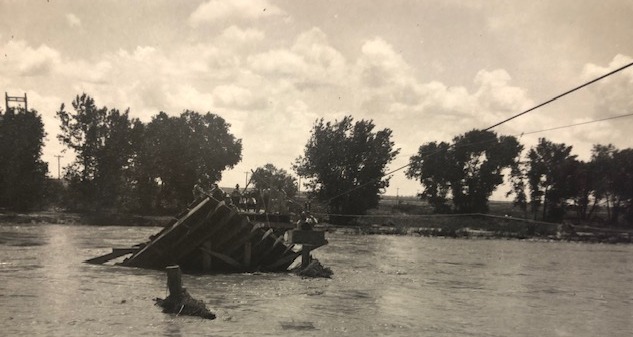In June 1921, the Pueblo Flood swept the Arkansas River Valley and left much destruction in its wake. Heavy rains began west of Pueblo at Dry Creek on June 2, leading the river to swell to more than thirteen feet on the gauge at Pueblo’s Main Street Bridge. Then intense rains began in the city on the afternoon of the 3rd. By midnight on the 4th, the flooding peaked at more than 24.5 feet. Levees broke in several spots and inundated a large part of Pueblo’s downtown covering the business district with water that reached a depth of 20 feet in some places.
Raging waters rushed down the Arkansas, and torrential rains exacerbated the problem. On June 3, Lakin’s Independent praised the much-needed and long-hoped-for rain, but a week later it was a very different story.
“The long looked for rain arrived Thursday evening, and it was no gentle shower, a five-inch fall being recorded and this stands for all parts of the county.” With high water cutting off nearly all transportation, mail carriers had a flood-enforced layoff, and Lakin was left without power when a pole carrying the transmission line was destroyed. Portions of the Santa Fe Railroad tracks between Hartland and Sutton, as well as two miles east of Lakin, were damaged. A set of farm buildings was carried away between Deerfield and Holcomb, and irrigation canals sustained damage from the high waters as well.
At Deerfield, part of their bridge across the river was “some where else than here now the high water taking it out.” Later reports said that 160 feet of the bridge was taken out, cutting off the South Side and greatly inconveniencing its residents.



The Hartland bridge was swept away as well. Lakin’s new concrete bridge which had been completed in 1917 withstood the rampage; however, the road south of the bridge was left in very poor condition. Reports came in that three men who came down the Arkansas river on logs were rescued near Kendall, and at Sutton, Will Thompson and his wife were found sitting on the highest hill north of the river. The Thompsons had fled there after moving their household goods to the upper story of the headgate house.
On June 17, The Advocate reported that the water at the south approach to the Lakin bridge was still too deep for automobiles, and South Side farmers were forced to make the trip to town with “the old and reliable horse and wagon.” Teams of horses were required to help cars that attempted the trip across this stretch of road. While it took much longer to repair the bridges, passenger and freight traffic on the Santa Fe between Dodge City and La Junta was finally resumed after a 12-day tie up.
At the highest mark, the flood water of the Arkansas did not spread to more than a mile wide here. According to the Independent, damage done by the flood was hard to estimate, but Kearny County had not suffered as great a loss as had a number of counties in eastern Colorado and Western Kansas. At Syracuse, Stillman Hixson drowned after aiding a number of tourists who were trapped in the high water. Hixson was hit by a nearly eight-foot high wall of water that came rushing down upon him and swept him off the railroad track where he had gone to seek safety.
The flood was the worst in Pueblo’s history, and the number of casualties is still unknown. Many bodies washed up later, some much later than the initial aftermath of the tragedy. Many victims did not have family looking for them because they were poor, single immigrants; others were never found. The list of missing people was nearly twice as long as the list of the deceased, ranging from 50 in the days after the flood to nearly 300 in the following weeks. In addition, some of those who were missing were later found alive but were not reported as such.
Buildings collapsed at Pueblo, some because train cars that were swept up in the flood had crashed into them. The spark from a downed power line ignited boards at a local lumber company and created a fire that damaged many of the remaining structures. Telephone lines were destroyed affecting communication between Pueblo and the rest of the state, and there was no power. The streets were littered with debris and mud, and decomposing bodies of livestock littered the Ark Valley. All told, the flood inundated 300 square miles and carried away more than 500 houses, along with 98 businesses or industrial buildings, 61 stores, 46 locomotives, and 1,274 railroad cars.
Prior to the Pueblo Flood, Kearny County had suffered its share of losses from Arkansas River flood waters, and the wooden bridges at Hartland, Lakin and Deerfield were frequently under deluge. On May 29, 1902, Thomas Hinsley drowned at Hartland while trying to save the bridge. The 52-year-old was taking up some flooring and was swept into the current. During that flood, Hartland’s bridge lost a span of 125 feet. In August of that year, the bridges at Kendall, Lakin and Deerfield all suffered damage “owing to the river being on a tare.”
Parts of the Hartland, Lakin and Deerfield bridges were taken out in early October 1904 when flood waters from Trinidad, Colorado flowed into the Arkansas at Las Animas and reached Kansas. Although the Kendall bridge was not damaged, Charles Johnson tried to cross the river there and lost one horse and a wagon in the rapidly swelling tide. By December 10, only the Hartland bridge had been repaired and was usable. Four years later, all three of Kearny County’s bridges were washed out when a cloudburst near Lamar, Colo., made the river rise rapidly. It was the most flood damage experienced here up until that time.
In May 1914, another flood washed away part of the Hartland and Lakin river bridges while the Deerfield bridge went unscathed. Then in September 1915, the Lakin bridge went out again. Word had been received that the Arkansas was out of its banks at Colorado, and this area was hit by the heaviest rainstorm of that season. “The flood reached this place at about 8 p.m.,” reported The Lakin Independent, “and the rush of the water was heard for miles.”
SOURCES: History Colorado.org; Colorado Encyclopedia.org; History of Kearny County Vol. II; archives of the Lakin Investigator, Lakin Independent, Advocate and Syracuse Journal; and Museum archives.
